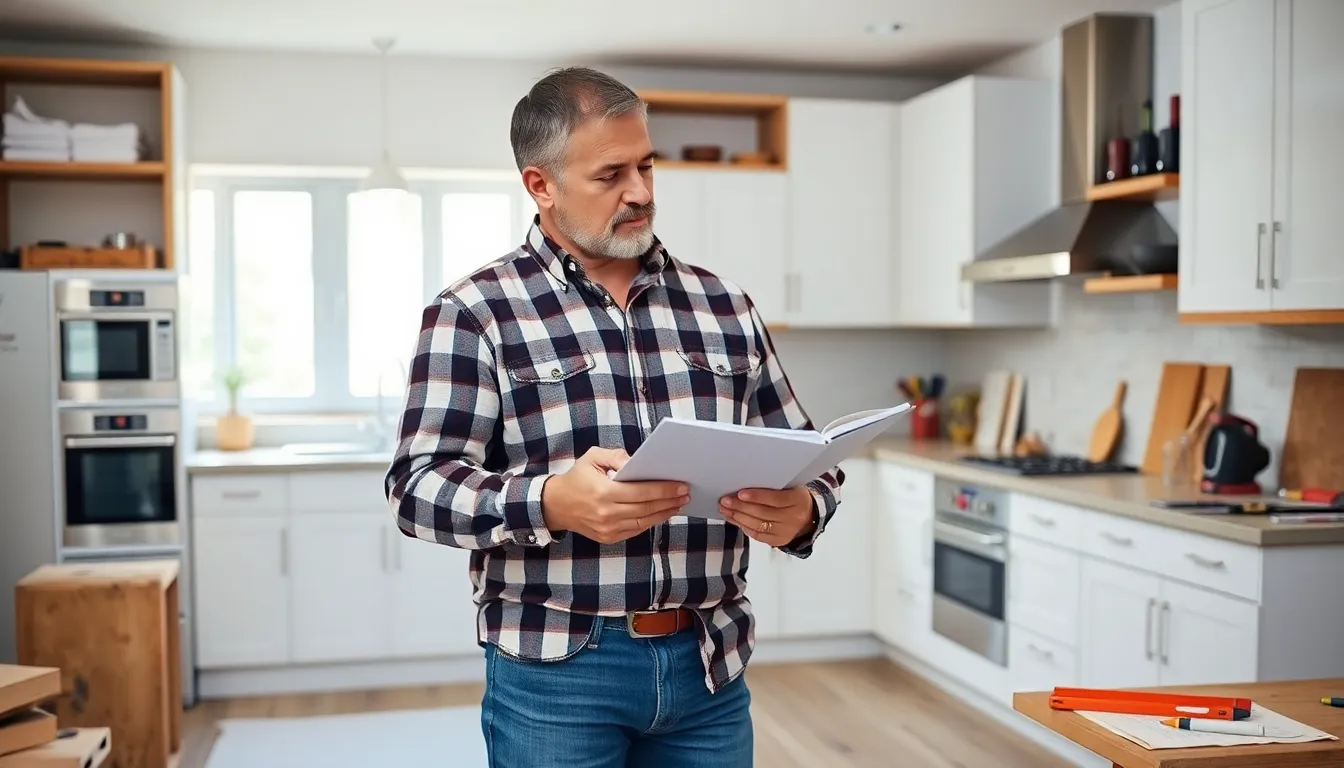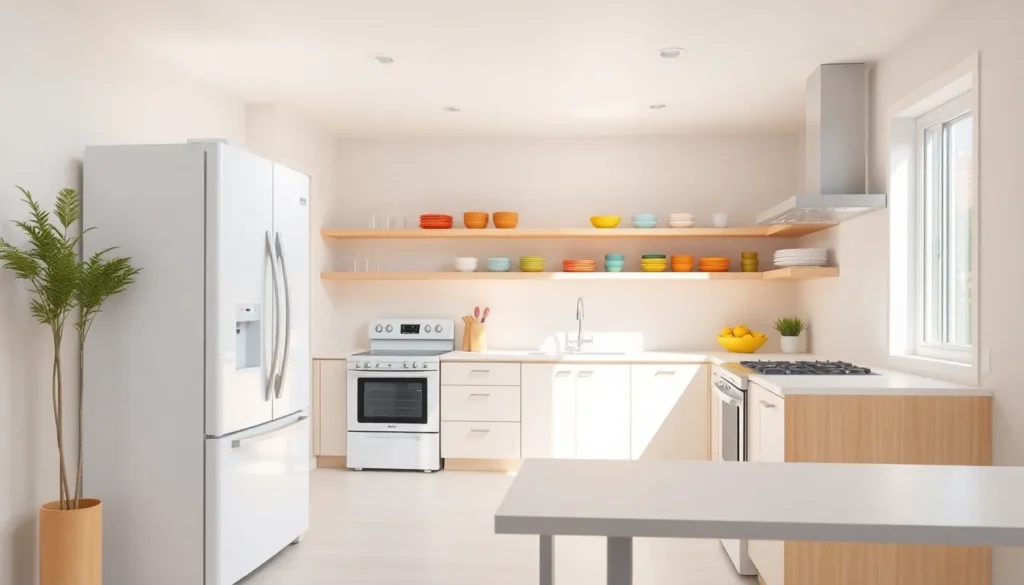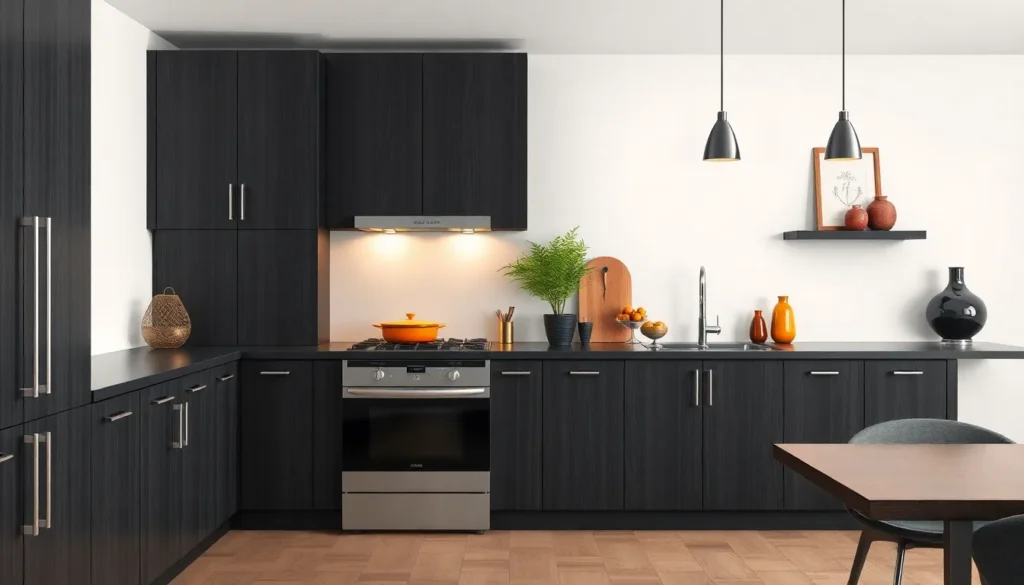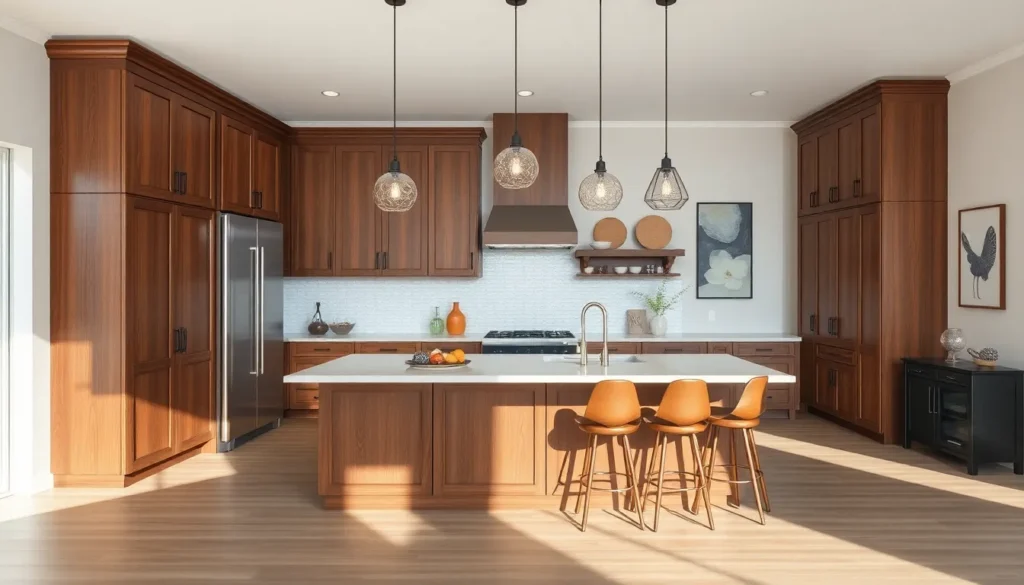A kitchen remodel can breathe new life into one of the most important spaces in a home. For many, the thought of a complete renovation might seem daunting, but with a DIY approach, it becomes an exciting opportunity to express creativity and enhance functionality. Whether it’s updating cabinets, installing new countertops, or adding a splash of paint, a hands-on project allows homeowners to tailor their kitchen to fit their unique style and needs.
Table of Contents
ToggleOverview of DIY Kitchen Remodel
A DIY kitchen remodel offers homeowners an opportunity to enhance their culinary space while exercising creativity. Homeowners often choose to upgrade various elements of their kitchen, such as cabinets, countertops, and paint, to improve both aesthetics and functionality.
- Cabinet Updates: Replacing or refinishing cabinets changes the overall look of the kitchen. Homeowners can opt for modern styles or classic designs that align with their taste.
- Countertop Installations: Switching to materials like quartz, granite, or butcher block provides durability and elegance. Choices depend on budget and kitchen usage.
- Appliance Upgrades: Energy-efficient appliances not only improve kitchen functionality but also reduce energy costs. Selecting the right appliances enhances both performance and style.
- Flooring Choices: Flooring options like tile, hardwood, or laminate can completely transform a kitchen’s environment. Choices should consider durability and ease of maintenance.
- Lighting Enhancements: Good lighting improves both ambiance and functionality. Installing pendant lights or under-cabinet lighting can brighten work areas effectively.
- Backsplash Installation: A stylish backsplash adds character and texture. Options range from ceramic tiles to glass, allowing for creative expression.
DIY kitchen remodels cater to various budgets and design preferences, making them a popular choice for many homeowners. Careful planning and precise execution lead to rewarding results that enhance the home.
Planning Your DIY Kitchen Remodel

Planning a DIY kitchen remodel involves careful consideration of key factors like budget and timeline. A well-structured plan ensures a smoother renovation process.
Setting a Budget
Setting a budget serves as the foundation for the remodel. He, she, or they should start by determining the total amount available for the project. Break down expenses into categories such as materials, labor, and permits. Consider allocating around 20% of the budget for unexpected costs. Prioritize elements like cabinets, countertops, and appliances to ensure they meet quality standards. For effective budgeting, it’s essential to research local prices for materials and labor; sites like HomeAdvisor or Lowe’s provide valuable insights.
| Budget Category | Estimated Percentage |
|---|---|
| Cabinets | 30% |
| Countertops | 20% |
| Appliances | 15% |
| Flooring | 10% |
| Labor (if applicable) | 15% |
| Miscellaneous/Permits | 10% |
Choosing a Timeline
Choosing a timeline significantly impacts the project’s success. Identify a start date and a completion date based on personal schedules and availability. Break the project into phases, such as demolition, installation, and finishing touches. Allocate enough time for each phase; for instance, construction might take two to four weeks, while finishing touches could take one week or more. Include buffer time for unexpected delays; at least one additional week can accommodate unforeseen challenges. Always communicate the timeline with any professionals involved to ensure everyone is aligned on expectations.
Essential Tools and Materials
A successful DIY kitchen remodel demands an array of tools and materials tailored to specific tasks. Utilizing the right equipment streamlines the process and enhances outcomes.
Must-Have Tools
- Tape Measure: Accurate measurements prevent costly mistakes. A 25-foot tape measure suffices for most kitchen dimensions.
- Level: Ensures all surfaces, from cabinets to countertops, remain even and properly aligned. A 24-inch level works effectively for most installations.
- Power Drill: Ideal for drilling holes and driving screws, a corded or cordless drill simplifies assembly tasks.
- Circular Saw: Cuts through various materials, including plywood and countertops. A 7-1/4 inch circular saw remains popular for kitchen projects.
- Screwdriver Set: Both flathead and Phillips head screwdrivers assist with assembling cabinets and fixtures.
- Utility Knife: Cuts through many materials, including drywall and flooring underlayment, adding versatility to the toolkit.
- Pry Bar: Essential for removing old cabinets or countertops without damaging surrounding areas.
- Safety Gear: Goggles, gloves, and a mask protect against debris and dust during renovation.
Recommended Materials
- Cabinets: Consider plywood or MDF for durability and a polished finish. Stock, semi-custom, or custom options cater to various budgets.
- Countertops: Choose granite, quartz, or butcher block for durability and aesthetic appeal. Each material varies in cost and maintenance needs.
- Flooring: Options like vinyl, tile, or hardwood offer a balance of style and functionality. Vinyl planks remain popular for their resilience and ease of installation.
- Paint: Use high-quality, moisture-resistant paint for cabinets and wall surfaces to ensure longevity.
- Backsplash Tiles: Consider ceramic, glass, or stone tiles to add a stylish touch and protect walls from cooking splatters.
- Lighting Fixtures: Select energy-efficient LED fixtures for under-cabinet lighting and overhead options to enhance ambiance and usability.
- Plumbing Fixtures: Choose faucets and sinks that complement your kitchen style and functionality. Stainless steel remains a favored option for durability.
Incorporating these essential tools and materials ensures a smoother, effective kitchen remodeling process.
Popular DIY Kitchen Remodel Ideas
Homeowners seeking to enhance their kitchens often explore popular DIY remodel ideas that deliver impactful results. The following sections detail effective strategies for transforming key elements of the kitchen.
Cabinet Refacing
Cabinet refacing presents an efficient way to refresh the kitchen’s look without full replacement. Homeowners can opt to retain existing cabinet structures, replacing or refinishing doors and fronts, which saves time and money. Using veneer or laminate can achieve a new style while creating a modern aesthetic. New hardware, such as handles and knobs, further updates the look. This approach provides a balance between budget and design, offering a refreshed kitchen with minimal disruption.
Backsplash Installation
Installing a new backsplash significantly enhances kitchen appeal and functionality. Various materials, including ceramic, glass, and peel-and-stick options, allow for personalization. Homeowners can consider designs that complement their color schemes, such as subway tiles for a classic look or patterned tiles for a bold statement. Proper measurement and adhesive application are crucial for a seamless finish. An integrated backsplash can also protect walls from moisture and stains, combining style with practicality.
Challenges to Consider
Undertaking a DIY kitchen remodel comes with unique challenges that homeowners must navigate for a successful transformation. Understanding potential obstacles can help in planning and execution.
Common Pitfalls
- Underestimating Costs: Homeowners often miscalculate total expenses. It’s essential to include hidden costs, such as permits and unexpected repairs, which can reach up to 15% of the total budget.
- Inaccurate Measurements: Incorrect measurements lead to ordering wrong-sized materials. Always double-check dimensions before purchasing cabinets or countertops to reduce waste and avoid delays.
- Neglecting Structural Changes: Structural elements, such as plumbing and electrical systems, may require professional intervention. Failing to address these can increase risk and complicate the remodeling process.
- Poor Timing: Rushing through the project may compromise quality. Allocating sufficient time for each phase ensures thoroughness and better results.
- Overlooking Safety Precautions: DIY projects often involve heavy lifting and power tools. Ignoring safety can lead to injuries; using safety gear and following guidelines is crucial.
Time Management Tips
- Create a Detailed Timeline: Break the project into phases, assigning realistic completion dates. Allocate extra days for unexpected delays to maintain a smooth workflow.
- Set Daily Goals: Establish achievable goals each day. Small, manageable tasks prevent overwhelm and maintain motivation throughout the remodel.
- Prioritize Tasks: Identify essential jobs that impact others. Completing critical tasks first, such as plumbing or electrical work, sets a solid foundation for subsequent steps.
- Plan for Downtime: Recognize that some phases, like drying paint or curing adhesives, require waiting. Plan non-dependent tasks during these periods to maximize efficiency.
- Stay Flexible: Adjust plans based on project progress. Adaptability is vital when unexpected challenges arise, allowing for timely issue resolution without derailing the schedule.
A DIY kitchen remodel offers homeowners an incredible opportunity to enhance their living space while expressing their unique style. With careful planning and the right tools, they can tackle various projects that breathe new life into their kitchens. Whether it’s updating cabinets or installing a new backsplash, each step contributes to a more functional and visually appealing environment.
By being mindful of budget and timeline, they can navigate potential challenges with confidence. Embracing creativity and resourcefulness turns the remodeling process into a rewarding experience. Ultimately, a well-executed DIY kitchen remodel not only elevates the home’s aesthetic but also adds lasting value, making it a worthwhile investment.









